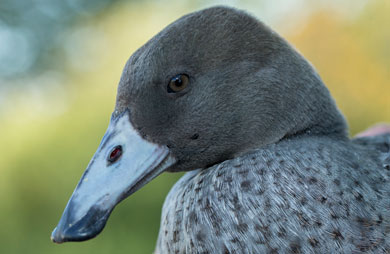Archived content: This media release was accurate on the date of publication.
Date: 01 March 2017

Whio
Image: Sabine Bernert ©
DOC and Genesis Energy are launching a whio 'duckface' selfie competition for Whio Awareness Month (1-31 March), aiming to raise awareness of New Zealand’s native river surfing blue duck and the fact that whio are one of New Zealand’s most endangered birds.
Whio are rarer than kiwi with 23 kiwi for every whio.
Since 2011, DOC and Genesis Energy have worked in partnership to protect whio. This work includes raising awareness of whio, and undertaking intensive work to protect and grow numbers of whio at key sites around New Zealand.
Together, DOC and Genesis Energy have boosted the number of whio protected at security and recovery sites from 300 to 533 pairs, and expanded the length of rivers protected from 831 km to 1428 km.
Jenny Burke, who heads the Whio Forever advocacy work for Genesis Energy, says that the gains made are “very encouraging” and have prompted the company to extend their support of the programme until 2021. “By then we hope to have reversed the fortunes of whio. At the moment there are less than 3000 whio – we hope to grow the population to 5000 by 2021”.
To enter the competition take a 'whio duckface selfie' and go to Whio Forever pucker-up . Selfies uploaded to the site, with an explanation of why they love whio, go in the draw to win a 'whio ranger for a day' experience. People can also show their support of whio by posting their selfie on social media with the hashtag #whioforever.
Background information
Whio
- The whio is a threatened species of native duck that is only found in New Zealand’s fast flowing waters. Featured on New Zealand’s $10 note and with an estimated nationwide population of less than 3000 birds, whio are rarer than kiwi.
- Whio are adapted to live on fast-flowing rivers so finding whio means you will also find clean, fast-flowing water with a good supply of underwater insects.
- This makes whio important indicators of ecosystem health – they only exist where there is high quality clean and healthy waterways.
Whio Forever Programme
- Genesis Energy has a strong historic association with whio through the Tongariro Power Scheme and in 2010 this association grew through the establishment of Whio Awareness Month(March).
- Today, Genesis Energy and DOC continue their partnership through the Whio Forever Programme, which aims to secure the future of whio in the wild and ensure New Zealanders understand and value of whio in our rivers.
- The support of Genesis Energy and the work f DOC has enabled the Whio Recovery Plan to be implemented.
Conservation
- Whio are eaten by stoats, ferrets and cats, with the largest impact during nesting time when eggs, young and females are vulnerable, and also when females are in moult and can’t fly.
- Extensive trapping can manage these predators and work in key whio habitats by DOC and Genesis Energy on the Whio Forever Project has already seen an increase in whio numbers.
- Whio cannot be moved to predator-free islands like other species because of their reliance on large fast-flowing rivers.
- Pairs occupy approximately 1 km of water – so they need a lot of river to sustain a large population and they fiercely defend their territories, which makes it difficult to put them with other ducks in captivity.
- They are susceptible to flood events which, destroy nests, fragment broods and wash away their valued food source.
Contact
For media enquiries contact:
Email: media@doc.govt.nz
Richard Gordon, Genesis Energy Public Affairs Manager
Mobile: +64 21 681 305
Email: richard.gordon@genesisenergy.co.nz